196. I have found only one
glyph in the C text which evidently
corresponds to a similar glyph in the G
text, viz Cb4-20:
 |
 |
 |
 |
|
Cb4-17 (88 = 480 - 392) |
Cb4-18 |
Cb4-19 |
91 (= 364 / 4) |
|
erua marama |
tagata noho i
to mea |
kua vaha |
|
MAY 14 |
15 |
136 (= 88 + 48 = 91 + 45) |
17 |
 |
 |
 |
 |
|
Ga2-24 |
Ga2-25 |
Ga2-26 |
Ga2-27 (57) |
Although it cannot be denied
that there is also a kind of
similarity between tagata
noho i to mea (person at
dawn, Cb4-19) and Ga1-26:
 |
 |
|
June 19 (*90) |
Cb4-19 (90) |
|
Tagata.
Man;
human being in general;
the plural is gagata.
Vanaga. Man, mankind;
tagata ke, some one
else; tagata no,
nation. P Pau.:
tagata, man. Mgv.:
tagata, man or
woman. Mq.: enata,
enana, kenana,
man. Ta.: taata,
id. Tagataa,
incarnate. Tagatahaga,
human, humanity.
Churchill. |
|
Noho.
1. To
sit, to stay, to remain,
to live (somewhere), to
wait; ka-noho,
you stay! (i.e.
'good-bye', said by the
person leaving). 2.
Figuratively: he noho
te eve, to be calm,
at peace; he noho te
mana'u, to
concentrate on
something, to fix one's
attention on; ku-noho
á te mana'u o te tagata
ki ruga ki te aga,
the man thinks
constantly of his work.
Vanaga.
Seat,
bench, dwelling,
marriage, position,
posture, situation,
session, sojourn; to
sit, to dwell, to
reside, to rest, to
halt, to inhabit;
noho hahatu,
to sit cross-legged;
noho hakahaga,
apathy;
noho heenua,
countryman;
noho kaiga,
native;
noho kenu,
married;
noho ke noho ke,
to change place;
noho muri, to
stay behind;
noho noa,
invariable;
noho opata,
to stand on a cliff;
noho pagaha,
badly placed;
noho pepe,
table;
noho tahaga,
bachelor, unmarried;
noho vie,
married,
noho no,
apathy, stay-at-home,
colonist, idler,
inhabitant, inactive,
immobile, settler, lazy,
loiterer.
Hakanoho, to
abolish, to rent, to
lease, to enslave, to
dissuade, to exclude, to
exempt, to install, to
substitute, hostage.
Hakanohohia,
stopped.
Nohoga, seat.
Nohoturi, to
kneel, genuflexion.
Nohovaega, to
preside. Churchill. |
|
To.
1. Particle
sometimes used with the
article in ancient legends;
i uto to te hau, the
ribbon was in the float. 2.
To rise (of the sun) during
the morning hours up to the
zenith: he-to te raá.
Vanaga. 1. Of. T Pau., Ta.:
to, of. Mgv.: to,
genitive sign. Mq.: to,
of, for. 2. This, which.
Churchill.
Mgv.: To,
to make a canoe of planks.
Mq.: to, to build a
canoe. Sa.: to, to
build. Churchill. |
|
Mea.
1. Tonsil,
gill (of fish). 2. Red
(probably because it is the
colour of gills); light red,
rose; also meamea. 3.
To grow or to exist in
abundance in a place or
around a place: ku-mea-á
te maîka, bananas grow
in abundance (in this
place); ku-mea-á te ka,
there is plenty of fish (in
a stretch of the coast or
the sea); ku-mea-á te
tai, the tide is low and
the sea completely calm
(good for fishing); mau
mea, abundance. Vanaga.
1. Red;
ata mea, the
dawn.
Meamea, red,
ruddy, rubricund, scarlet,
vermilion, yellow;
ariga meamea,
florid;
kahu meamea
purple;
moni meamea,
gold;
hanuanua meamea,
rainbow;
pua ei meamea, to
make yellow.
Hakameamea, to
redden, to make yellow. PS
Ta.:
mea, red. Sa.:
memea,
yellowish brown, sere. To.:
memea, drab.
Fu.:
mea, blond,
yellowish, red, chestnut. 2.
A thing, an object, elements
(mee);
e mea,
circumstance;
mea ke,
differently, excepted, save,
but;
ra mea, to
belong;
mea rakerake,
assault;
ko mea, such a
one;
a mea nei, this;
a mea ka, during;
a mea, then;
no te mea,
because, since, seeing that;
na te mea, since;
a mea era, that;
ko mea tera,
however, but.
Hakamea, to
prepare, to make ready. P
Pau., Mgv., Mq., Ta.:
mea, a thing.
3. In order that, for. Mgv.:
mea, because,
on account of, seeing that,
since. Mq.:
mea, for. 4.
An individual;
tagata mea,
tagata mee, an
individual. Mgv.:
mea, an
individual, such a one. Mq.,
Ta.:
mea, such a
one. 5. Necessary, urgent;
e mea ka, must
needs be, necessary;
e mea, urgent. 6.
Manners, customs. 7. Mgv.:
ako-mea, a red
fish. 8. Ta.:
mea, to do.
Mq.:
mea, id. Sa.:
mea, id. Mao.:
mea, id.
Churchill. |
|
Vaha.
Hollow;
opening; space between the
fingers (vaha rima);
door cracks (vaha papare).
Vahavaha, to fight,
to wrangle, to argue with
abusive words. Vanaga. 1.
Space, before T; vaha
takitua, perineum. PS
Mgv.: vaha, a space,
an open place. Mq.: vaha,
separated, not joined. Ta.:
vaha, an opening.
Sa.: vasa, space,
interval. To.: vaha,
vahaa, id. Fu.:
vasa, vāsaà,
id. Niuē: vahā.
2. Muscle, tendon;
vahavaha,
id. Vahahora
(vaha
1 - hora
2), spring.
Vahatoga
(vaha
1 - toga
1), autumn. 3. Ta.:
vahavaha,
to disdain, to dislike. Ha.:
wahawaha,
to hate, to dislike.
Churchill. |
|
Egyptian
door |
 |
Phoenician
dalet |
 |
Greek
delta |
Δ (δ) |
...
Delta
(uppercase Δ,
lowercase δ) ... is
the fourth letter of
the Greek alphabet.
In the system of
Greek numerals it
has a value of 4. It
was derived from the
Phoenician letter
Dalet. Letters
that come from delta
include Latin D and
Cyrillic Д. A river
delta (originally,
the Nile River
delta) is so named
because its shape
approximates the
upper-case letter
delta (the shape is
a triangle) ...
Dalet (dāleth,
also spelled
Daleth or
Daled) is the
fourth letter of
many Semitic
alphabets ... The
letter is based on a
glyph of the Middle
Bronze Age
alphabets, probably
called dalt
'door' (door in
Modern Hebrew is
delet),
ultimately based on
a hieroglyph
depicting a door.

|
The correspondence
between Ga2-26 and Cb4-20 should be
verified by looking at the
stars:
 |
 |
 |
 |
 |
9 |
|
Cb4-3 (466 → 366 + 100) |
Cb4-4 (91 - 16) |
Cb4-5 |
Cb4-6 (77 = 103 - 26) |
Cb4-7 |
|
te hakaua |
te henua |
te Rei |
te ua |
kiore - henua |
|
Dec 29 (*101 + *182) |
30 |
31 |
Jan 1 (366 = 184 + 182) |
2 |
|
ζ Pavonis (283.4), λ
Cor. Austr. (283.6),
DOUBLE DOUBLE = ε Lyrae
(283.7), ζ Lyrae (283.8) |
South Dipper-8 (Unicorn)
Φ
Sagittarii
(284.0), μ Cor. Austr.
(284.6), η Cor. Austr.,
θ Pavonis (284.8) |
SHELIAK (Tortoise) = β
Lyrae,
ν Lyrae (285.1), ο
Draconis (285.5). λ
Pavonis (285.7)
ATLAS (27 Tauri) |
χ Oct. (286.0),
AIN AL RAMI
(Eye of the Archer) = ν
Sagittarii
(286.2), υ Draconis
(286.4), δ Lyrae
(286.3), κ Pavonis
(286.5),
ALYA = θ Serpentis
(286.6) |
ξ Sagittarii (287.1), ω
Pavonis (287.3), ε
Aquilae, ε Cor. Austr.,
SULAPHAT (Little
Tortoise Shell) = γ
Lyrae
(287.4), λ Lyrae
(287.7),
ASCELLA
(Armpit) = ζ Sagittarii,
BERED = i Aquilae (Ant.)
(287.9) |
|
June 30 |
July 1 |
2 (183 = 365 - 182) |
3 |
4 |
|
SIRIUS
= α Canis Majoris
(101.2), ψ5 Aurigae
(101.4), ν Gemini
(101.6), ψ6 Aurigae
(101.7)
|
τ Puppis (102.2), ψ7
Aurigae (102.4) |
Mash-mashu-sha-Risū-9
(Twins of the Shepherd)
ψ8 Aurigae (103.2),
ALHENA
= γ Gemini
(103.8), ψ9 Aurigae
(103.9) |
ADARA (Virgins) = ε
Canis Majoris
(104.8) |
ω Gemini (105.4),
ALZIRR (The Button) = ξ
Gemini
(105.7),
MULIPHEIN (Oaths) = γ
Canis Majoris
(105.8),
MEKBUDA (Contracted) = ζ
Gemini
(105.9) |
 |
 |
 |
 |
|
Cb4-17 |
Cb4-18 (88 = 481 - 393) |
Cb4-19 |
Cb4-20 (91 = 364 / 4) |
|
erua marama |
tagata noho i
to mea |
kua vaha |
|
Jan 12 (365 + 12) |
13 (378 = 290 + 88) |
14 |
15 (300 + 80 = 88 + 4 * 73) |
|
ε Sagittae (297.1), σ Aquilae
(Ant.) (297.4),
SHAM
(Arrow)
= α Sagittae
(297.8) |
β Sagittae (298.0), χ Aquilae
(298.3), ψ Aquilae (298.8) |
υ Aquilae (299.1),
TARAZED
(Star-striking Falcon) = γ Aquilae
(299.3), δ Sagittae (299.6), π
Aquilae (299.9) |
TYL = ε Draconis
(300.0), ζ Sagittae (300.1),
ALTAIR
(Flying Eagle)
= α Aquilae
(300.3), ο Aquilae (300.5),
BEZEK = η Aquilae (Ant.)
(300.8) |
|
July 14 |
15 (196 = 378 - 182) |
16 |
17 (*118 = *300 - *182) |
|
α
Monocerotis
(115.4), σ Gemini (115.7) |
Mash-mashu-arkū-11
(Eastern One of the Twins)
κ
Gemini (116.1),
POLLUX
= β Gemini
(116.2), π Gemini (116.9) |
AZMIDISKE = ξ Puppis
(117.4) |
Φ
Gemini (118.4) |

By subtracting 182
days from January 13 (Cb4-18) - where 378 (=
54 weeks) equals the synodic cycle of
Saturn - we will find nakshatra
Pollux, the eastern twin - so named
probably because once upon a time he
had been ruling the dawn of the year
- when seen close to the Full Moon.
*116 (Pollux) - *88 (Betelgeuze) = *28 =
540 / 5
- 80 (0h).
|
Synodic cycles |
|
Mercury |
115.88 |
|
Venus |
583.92 |
|
|
|
Mars |
779.96 |
|
Jupiter |
398.88 |
|
Saturn |
378.09 |
|
Uranus |
369.66 |
184 (= *300 - *116)
days later was Altair, the Eagle.
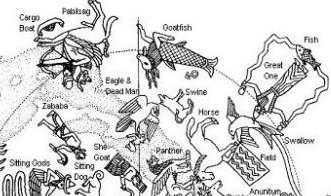
... In late September or early
October 130, Hadrian and his
entourage, among them Antinous,
assembled at Heliopolis to set sail
upstream as part of a flotilla along
the River Nile. The retinue included
officials, the Prefect, army and
naval commanders, as well as
literary and scholarly figures.
Possibly also joining them was
Lucius Ceionius Commodus, a young
aristocrat whom Antinous might have
deemed a rival to Hadrian's
affections. On their journey up the
Nile, they stopped at Hermopolis
Magna, the primary shrine to the god
Thoth. It was shortly after this, in
October [in the year A.D.] 130 -
around the time of the festival of
Osiris - that Antinous fell into the
river and died, probably from
drowning. Hadrian publicly announced
his death, with gossip soon
spreading throughout the Empire that
Antinous had been intentionally
killed. The nature of Antinous's
death remains a mystery to this day,
and it is possible that Hadrian
himself never knew ...
But at Ga2-26 the Aquila
constellation was at the Full Moon
half a year away at the time when the Sun in MAY
16 (136) had been at heliacal Pollux:
|
APRIL 27 |
28 (118 = 2 * 59) |
29 |
30 (120 = 180 - 60) |
MAY 1 (*41 = *101 - *60) |
12 |
 |
 |
 |
 |
 |
|
Ga2-7 |
Ga2-8 (36) |
Ga2-9 |
Ga2-10 |
Ga2-11 |
|
ºJune 26 (354 / 2) |
27 (365 - 183 - 4) |
28 |
29 (180) |
30 (*288 - *187) |
|
β Monocerotis, ν Gemini
(97.0) |
no star listed (98) |
ν Puppis (99.2), ψ3 Aurigae
(99.4), ψ2 Aurigae (99.5)
GEMMA (α Cor. Bor.) |
ψ4 Aurigae (100.5),
MEBSUTA (Outstretched) = ε
Gemini
(100.7) |
SIRIUS
= α Canis Majoris
(101.2), ψ5 Aurigae (101.4),
ν Gemini (101.6), ψ6 Aurigae
(101.7) |
|
Dec 30 |
31 (365 = 178 + 187) |
Jan 1 |
2 |
3 (181 + 187 = 368) |
|
South Dipper-8 (Unicorn)
Φ
Sagittarii
(284.0), μ Cor. Austr.
(284.6), η Cor. Austr., θ
Pavonis (284.8)
|
SHELIAK (Tortoise) = β Lyrae,
ν Lyrae (285.1), ο Draconis
(285.5). λ Pavonis (285.7)
ATLAS (27 Tauri) |
χ Oct. (286.0),
AIN AL RAMI
(Eye of the Archer) = ν
Sagittarii
(286.2), υ Draconis (286.4),
δ Lyrae (286.3), κ Pavonis
(286.5),
ALYA = θ Serpentis
(286.6) |
ξ Sagittarii (287.1), ω
Pavonis (287.3), ε Aquilae,
ε Cor. Austr.,
SULAPHAT (Little Tortoise
Shell) = γ Lyrae
(287.4),
λ Lyrae (287.7),
ASCELLA
(Armpit) = ζ Sagittarii,
BERED = i Aquilae (Ant.)
(287.9) |
Al Na'ām-18 (Ostriches)
/
Uttara Ashadha-21
(Elephant tusk, small bed)
NUNKI
= σ Sagittarii
(288.4), ζ Cor. Austr.
(288.5),
MANUBRIUM = ο Sagittarii
(288.8), ζ Aquilae (288.9) |
|
MAY 14 |
15 (500 = 365 + 135) |
136 (= 88 + 48 = 91 + 45) |
17 |
 |
 |
 |
 |
|
Ga2-24 |
Ga2-25 |
Ga2-26 (56 = 136 - 80) |
Ga2-27 (→ π) |
|
ºJuly 13 |
14 (195 = 181 + 14) |
15 (196 = 136 + 60) |
16 (384 - 187 = 197) |
|
ANA-TAHUA-VAHINE-O-TOA-TE-MANAVA-7
(Pillar for elocution)
υ Gemini (114.0),
MARKAB PUPPIS = κ Puppis
(114.7), ο Gemini (114.8),
PROCYON
= α Canis Minoris
(114.9) |
α
Monocerotis
(115.4), σ Gemini (115.7) |
Mash-mashu-arkū-11
(Eastern One of the Twins)
κ Gemini (116.1),
POLLUX
= β Gemini
(116.2), π Gemini (116.9) |
AZMIDISKE = ξ Puppis
(117.4) |
|
Jan 16 |
17 |
18 (13 * 29½ - ½) |
19 (384) |
|
ι Sagittarii (301.2),
TEREBELLUM = ω Sagittarii,
ξ Aquilae (301.3),
ALSHAIN
(Falcon)
= β Aquilae
(301.6),
φ Aquilae
(301.8) |
ε Pavonis, θ Sagittarii
(302.3), γ Sagittae (302.5),
μ Pavonis (302.7) |
τ
Aquilae
(303.8) |
η Sagittae (304.2), δ
Pavonis (304.4) |

At the other side of
the Milky Way compared to the claw
of the Eagle (below his feathered
wings) - evidently illustrating
departure - there should be rebirth
and indeed this we can see at
Ninmah:

... Sagittarius has
his front feet on the Cargo Boat
[Corona Australis] and below
Serpent there is another boat in
form of the headgear of Ninmah.
This headgear should be contrasted
with the feathers adorning the
preceding Eridu. Feathers on
the head ought to be a sign which
shows Sun in his last stage, when he
is hidden away ...
Eridu
is far deep down and we should
remember this is the place where
fire was kept:
... In the morning of the world,
there was nothing but water. The
Loon was calling, and the old man
who at that time bore the Raven's
name, Nangkilstlas, asked her
why. 'The gods are homeless', the
Loon replied. 'I'll see to it', said
the old man, without moving from the
fire in his house on the floor of
the sea. Then as the old man
continued to lie by his fire, the
Raven flew over the sea. The clouds
broke. He flew upward, drove his
beak into the sky and scrambled over
the rim to the upper world. There he
discovered a town, and in one of the
houses a woman had just given birth.
The Raven stole the skin and form of
the newborn child.
The Raven stole the skin and form of
the newborn child. Then he began to
cry for solid food, but he was
offered only mother's milk. That
night, he passed through the town
stealing an eye from each
inhabitant. Back in his foster
parents' house, he roasted the eyes
in the coals and ate them, laughing.
Then he returned to his cradle, full
and warm. He had not seen the old
woman watching him from the corner -
the one who never slept and who
never moved because she was stone
from the waist down. Next morning,
amid the wailing that engulfed the
town, she told what she had seen.
The one-eyed people of the sky
dressed in their dancing clothes,
paddled the child out to mid-heaven
in their canoe and pitched him over
the side.
He turned round and round to the
right as he fell from the sky back
to the water. Still in his cradle,
he floated on the sea. Then he
bumped against something solid.
'Your illustrious grandfather asks
you in', said a voice. The Raven saw
nothing. He heard the same voice
again, and then again, but still he
saw nothing but water. Then he
peered through the hole in his
marten-skin blanket. Beside him was
a grebe. 'Your illustrious
grandfather asks you in', said the
grebe and dived. Level with the
waves beside him, the Raven
discovered the top of a housepole
made of stone. He untied himself
from his cradle and climbed down the
pole to the lowermost figure.
Hala qaattsi ttakkin-gha,
a voice said: 'Come inside, my
grandson.' Behind the fire, at the
rear of the house, was an old man
white as a gull. 'I have something
to lend you', said the old man. 'I
have something to tell you as well.
Dii hau dang iiji: I am you.'
Slender bluegreen things with wings
were moving between the screens at
the back of the house. Waa'asing
dang iiji, said the old man
again: That also is you
...
...
Ninmah
has a child in her lap. Probably the
old man at the bottom of the sea was
Xiuchtecuhtli, who had a
brazier on his head:
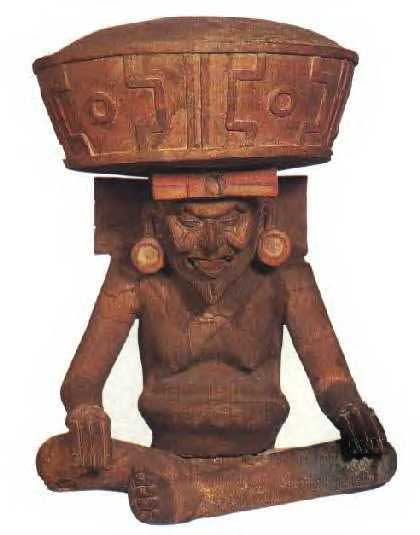
I guess Ninmah had a boat as
her headgear because it meant 'land'
had been reached - from Eridu
'the path of milk' went upwards
again and next station was Harrow
(followed by Abyss
described similar to Field).
Fire feathers on top of the head of
the Eridu figure is equally
strange as a boat on top of the head
of Ninmah - how can there be
fire down in the 'deep water' and
how can there be a boat up on 'dry
land'?
In
the Babylonian zodiac Jupiter is
located at the end of the 2nd
quadrangle below the head of
Leo.
Old Sun became 'Father Light' and
sired the next little 'fire' - the
head of the serpent is equally close
as that of the lion.
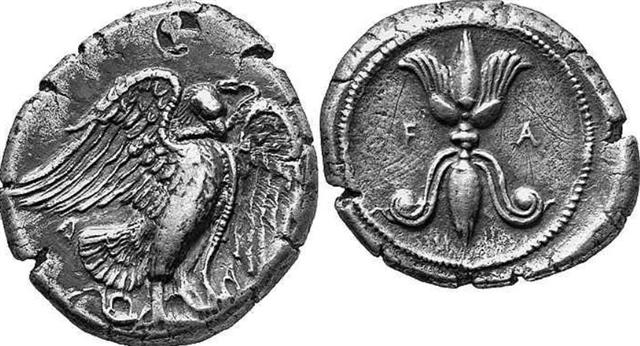
The feather headdresses of Eridu
and Bow would not survive
past the
point where the Milky Way made a
sharp bend at bottom. Sun did not
continue to where our own year is
ending but to the end of the first
half of our year. If Mad Dog
stood
at autumn equinox, then Old Sun could
have ended his days at midsummer.
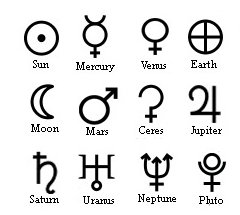
But Ninmah has a little child
in front of her and she carries a
Sun sign in her canoe hairdo. Once
it was popular for the women on
Easter Island, I remember, to carry
hats formed like boats:

Ninmah was
Vela (the Sail) in Argo Navis and a
Sail was named Ra in
Polynesia:
... The substitution
of the sun for the sail, both of
which are called ra or raa
in Polynesia, is a remarkable
feature in Easter Island art ...
... Beyond summer solstice comes the
back side of the year. It does not
mean, however, that 'sea' is
beginning already with Ninmah,
we should rather look where the
Milky Way is submerging the ecliptic.
The ecliptic path of
the planets is a straightforward
matter, it never curves. In contrast
the Milky Way is never straight, it
is like a river. With Eridu
at the end of the river, i.e. very
far down, we should look up in the
high mountains in order to find the
beginning, the small streams which
will grow in size with time.
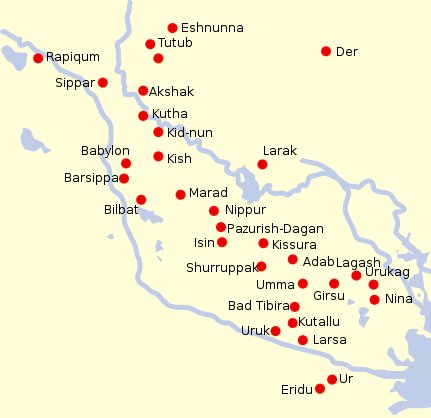
The season of this downward flow of
sweet water was imagined to begin
with Aquarius:
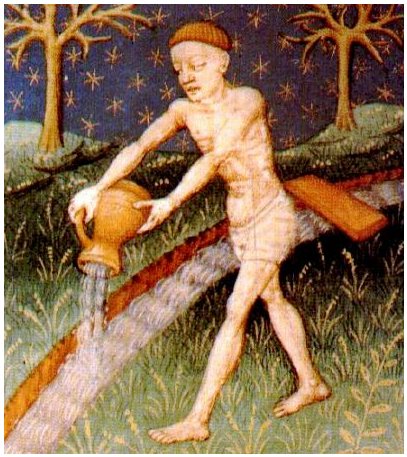
The curve of the stream indicates
Aquarius is standing on a hill.
Once upon a time Aquarius must have
stood at winter solstice, at the
beginning of the solar year north of
the equator. Maybe an initial
quarter of Aquarius later was
expanded to reach all the way down
to Leo. Or maybe already from the
beginning Aquarius stretched all the
way to the head of the Lion,
beyond Gemini. 'Land' certainly must
have arrived when Leo rose
heliacally, so much is clear from
the theory of correspondences
...
.jpg)
|
















.jpg)